
Sir Kenneth Clark introduces Voltaire, “one of the most intelligent men that has ever lived,” and the exemplary philosophe (‘public intellectual’) of the French Enlightenment. In this installment, The Smile of Reason, he describes the origins of this intellectual rebellion in the polite conversations of the Parisian salons of the early 18th century, and compares them to the anarchic England of Hogarth, and the exactness of the Scots. He sees the Enlightenment impulse exemplified in the great European palaces of Blenheim and Versailles in Europe, and Thomas Jefferson’s Monticello in the New World.
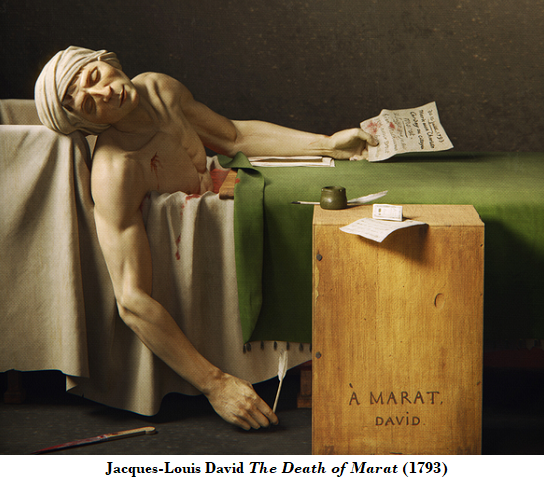
Why Smile? As Clark observes of the earlier era explored in the previous weeks: “We’ve got into deep water in the last 50 years.” And so perhaps we feel that the smiles of Voltaire and his fellow philosophes are inappropriate, and that “people ought to be more passionate and more committed,” in the face of the “senseless persecutions and brutal wars” of the 17th century. Perhaps, he concedes,
the smile of reason may seem to betray certain incomprehension of the deeper human emotions
which find expression in destruction and atrocity. However, it did encompass “some strongly held beliefs: in natural law, justice, and toleration.” And these were “not bad,” Clark suggests.
English Influence: Much of the inspiration for this secular optimism came from England and philosophers and scientists like Locke and Newton, as the philosophes acknowledged, and it was to England that they escaped to avoid being beaten and imprisoned by outraged aristocrats and government officials.
Country Houses: In England it was the age of great country houses, including Blenheim Palace (below), which Voltaire typically dismissed as “a great heap of stone, without charm or taste.” (It is now a UNESCO world Heritage site.)
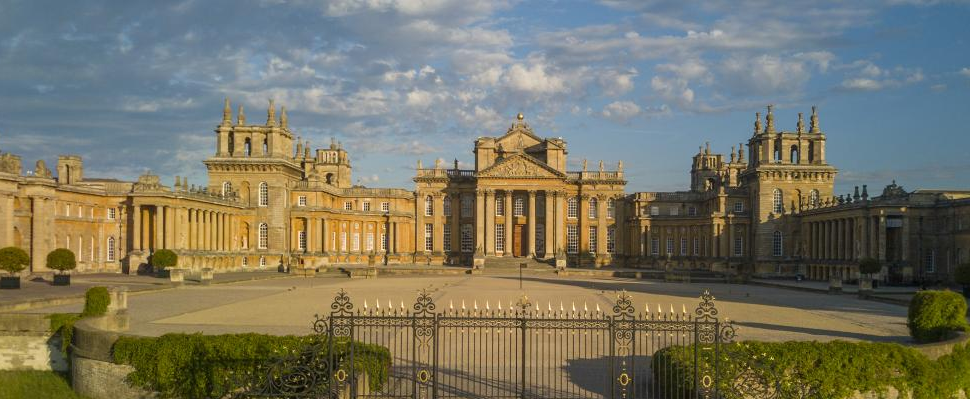
The Amateur Ideal: Blenheim was designed by an amateur architect when England was
the paradise of the amateur, where men rich enough and grand enough could do whatever they liked,
in the nature of monumental buildings. Clark remarks that such men were “inheritors of the Renaissance ideal of the universal man.” Indeed, 18th century amateurism was everywhere: chemistry, philosophy, botany and natural history, and was typified by Sir Joseph Banks.

The Other Side: Behind this immense wealth and privilege was another world altogether. As Clark says,
18th century, in the aftermath of its middle-class revolution, had created two societies, very remote from one another. One was the society of modest country gentlemen; the other was the urban society.
The first was decorous, spacious, and sedate; the latter was rude, crowded, and raucous, and was well-recorded by Hogarth.
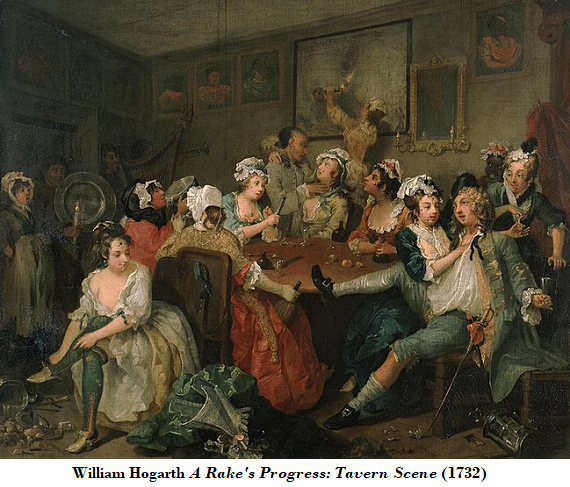
Civilised Decorum: Clark contrasts Hogarth’s scenes of un-civilised chaos and debauchery with a picture of another gathering by French painter Jean-François de Troy, Reading from Molière, which displays the epitome of civilised decorum (below) – even the furniture is civilised! This, Clark believes, reflects the role that women came to play in French polite society during the 18th century. Indeed,
I think it is absolutely essential to civilisation that the male and female principles are kept in balance
and so the salons conducted by leading Parisian ladies “were for 40 years the centres of European civilisation.”
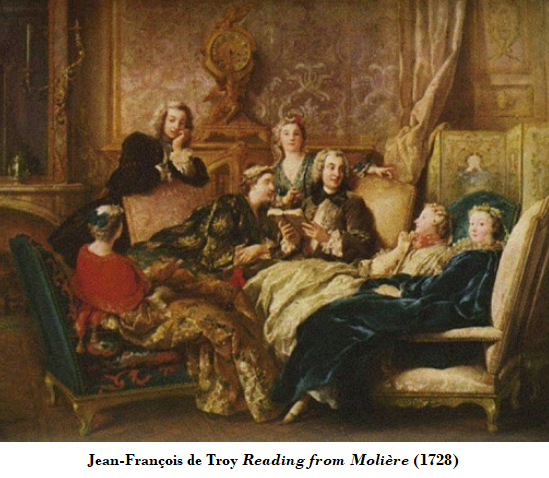
Importance of Paris: Such salons were possible because Paris was free of “the stultifying rituals of court procedure and trivial day-to-day preoccupations of politics,” that dominated Versailles. They were also not dominated by excessive wealth and luxury:
The salons where the brightest intellects of France were assembled were in rooms of a normal size, and the ornamentation was not so elaborate as to impose a formal behaviour. People could feel that they had natural human relationships with one another.
Revolutionary Agenda: The philosophes and their sponsors had revolutionary aims:
They were not merely a group of fashionable good-timers. They were the outstanding philosophers and scientists of the time. They wanted to publish their very revolutionary views of religion. They wanted to curtail the power of a lazy king and an irresponsible government. They wanted to change society.
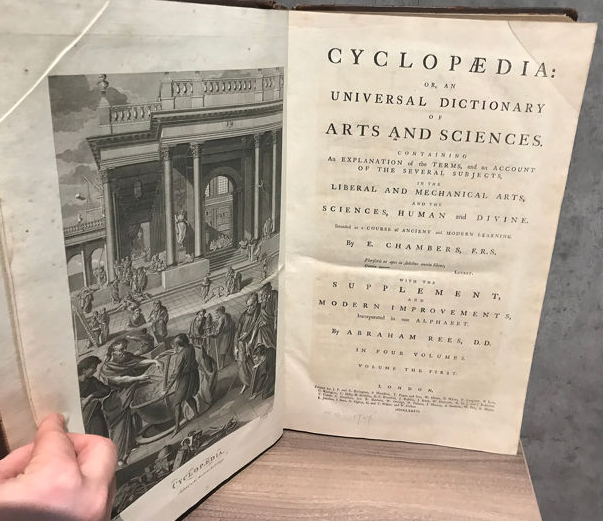 Eventually, in 1789 they got their wish, “and rather more of a change than they had bargained for!”
Eventually, in 1789 they got their wish, “and rather more of a change than they had bargained for!”
The Encyclopédie: It was in the 18th century that there emerged the modern concept of an encyclopaedia of all knowledge, discussed in depth, and organized in a systematic fashion. Ephraim Chambers’ Cyclopaedia appeared in England in 1728 (left), and was followed from 1751 onwards by the Encyclopédie edited by the philosophes, Denis Diderot and Jean le Rond d’Alembert, and then by the Encyclopædia Britannica, published in Edinburgh, in 1768. Diderot was a polymath, as was d’Alembert, who was also a major mathematician.

Subversion: The Encyclopédie ran to 28 volumes; its aim was “to collect all knowledge scattered over the face of the earth” and took some 20 years to complete.
The entire project was deeply political; it didn’t just convey knowledge — surreptitiously it offered a scathing critique of the monarchy, the political regime, the Church, and all traditional institutions. It also used tricks to ridicule the status quo, e.g., under the entry for ‘Eucharist’ it read ‘see Cannibalism’. Diderot had already been imprisoned for his activities and this time he had the Encyclopédie published in Switzerland and smuggled into France, where it caused a sensation. As Clark observes,
authoritarian governments don’t like such compendiums. They live by lies and bamboozling abstractions
and can’t afford to have words accurately defined or complex subjects explained. Suspecting intellectual subversion the state twice suppressed the Encyclopédie. However, it flourished “and the elegant salons became precursors of revolutionary politics.”
The Scottish Enlightenment: Digressing, Clark takes us to Scotland to describe how 18th century Scotland — “a poor, remote and semi-barbarous country” — became one of the great powerhouses of the Enlightenment. It boasted intellectual giants such as Adam Smith, David Hume, Joseph Black, and James Watt — men who “changed the whole current of European thought and life.”
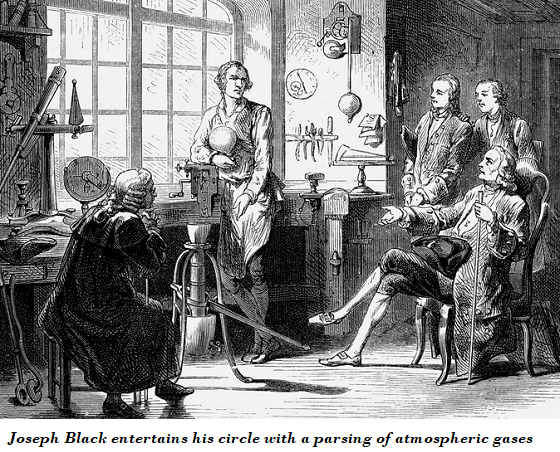
These luminaries were joined by James Boswell, who wrote the Life of Samuel Johnson, “one of the most entertaining books in the English language;” Sir Walter Scott, who “popularized the Gothic Middle Ages and furnished the imagination of the romantically-minded for a century;” Robert Burns, “the first great popular lyricist;” and Sir Henry Raeburn, who “painted the members of this remarkable society with an inspired directness.”
Edinburgh: All of these great Scotsmen lived in the grim, narrow tenements of the Old Town of Edinburgh
where a romantic landscape comes right into the centre of town ~ until, in their lifetime, two Scottish architects, the brothers Adam, produced one of the finest pieces of town planning in Europe — the new town of Edinburgh (below)
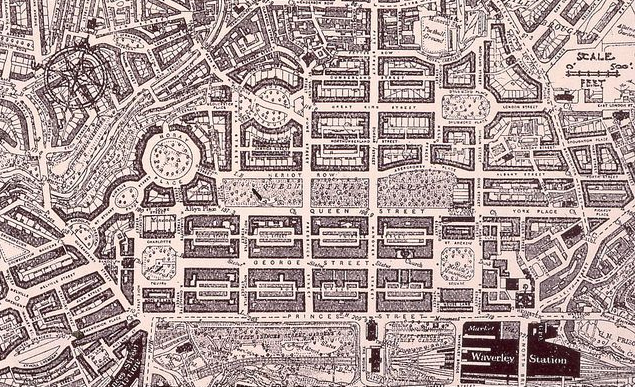
Practical Knowledge: The impact of these philosophers, scientists, and engineers, was primarily practical, and they caused much of the technical content of the Encyclopédie to be updated.
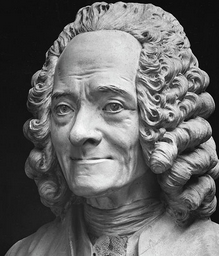 Voltaire: Returning to France, Clark explores the long life of Voltaire. Voltaire represented the militant reformist side of the Enlightenment, denouncing the Ancien Régime (the absolutist political system that had dominated France since the Late Middle Ages), conventional religion and philosophy, and all forms of injustice. Extremely prolific, Voltaire (right) produced a steady stream of critical works and commentary right through the 18th century.
Voltaire: Returning to France, Clark explores the long life of Voltaire. Voltaire represented the militant reformist side of the Enlightenment, denouncing the Ancien Régime (the absolutist political system that had dominated France since the Late Middle Ages), conventional religion and philosophy, and all forms of injustice. Extremely prolific, Voltaire (right) produced a steady stream of critical works and commentary right through the 18th century.
Candide: Voltaire’s best known and most influential book is Candide. It tells the often very funny story of the steady disillusionment of a naïve young man. Candide was snatched suddenly from a sheltered life where he wants for nothing and is driven into a dangerous nomadic existence that  takes him and a growing network of friends all over Europe and the New World. There he experienced or witnessed all the tragedies and atrocities that afflicted the world at that time e.g. endless wars, and the Great Lisbon earthquake that engulfed the city on the morning All Saints’ Day, 1755, killing some 60,000 people. The main theme of Candide is the shift from an optimistic and complacent view of the world to a more pessimistic recognition that the best we can hope for is a chance to quietly ‘cultivate our garden’. It was immediately banned for its attacks on important political and religious figures and doctrines.
takes him and a growing network of friends all over Europe and the New World. There he experienced or witnessed all the tragedies and atrocities that afflicted the world at that time e.g. endless wars, and the Great Lisbon earthquake that engulfed the city on the morning All Saints’ Day, 1755, killing some 60,000 people. The main theme of Candide is the shift from an optimistic and complacent view of the world to a more pessimistic recognition that the best we can hope for is a chance to quietly ‘cultivate our garden’. It was immediately banned for its attacks on important political and religious figures and doctrines.
Refuge: Wary of arrest, Voltaire made his home on the border with Switzerland, where he could quickly flee for asylum if necessary. Clark emphasizes his intelligence, quick wit, humour, elegant style, and fierce commitment to justice. After spending much of his life as an outcast, Voltaire’s return to Paris in old age was a triumph
No victorious general, no lone flyer has ever been given such a reception. He was hailed as the universal man and the friend of humanity.
He was mobbed everywhere he went, and died triumphant in 1778, aged 83. Eleven years later the French Revolution overthrew the Ancien Régime, and plunged France and most of Europe into decades of bloodshed.
Some Quotes from Voltaire:
“God is a comedian playing to an audience too afraid to laugh.”
“To succeed in the world it is not enough to be stupid, you must also be well-mannered.”
“Think for yourselves and let others enjoy the privilege to do so too.”
“Those who can make you believe absurdities can make you commit atrocities.”
“There are some who only employ words for the purpose of disguising their thoughts.”
“It is dangerous to be right when the government is wrong.”
From Renaissance to Enlightenment: The 250 years between the Renaissance and the Enlightenment saw a major shift away from the Church. Centuries of religious wars and disgust at clerical ignorance and corruption fed into atheism, underpinned by a militant materialism that was particularly strong in France. Voltaire proclaimed his contempt for institutional religion at every opportunity. The materialists insisted that there was no intrinsic basis to morality and that all so-called moral acts were “due to an accidental conjunction of nerves and tissues.” It was a radical view in 1770 but not one upon which a civilisation could be founded, as the French Revolution soon demonstrated.
Foundations of a New Morality: The 18th century was faced with the question of how to construct a morality based on neither the Bible nor any other religious system. The solution was built on two foundations:
one was the doctrine of natural law; the other the stoic philosophy of Ancient Rome.
Combined, these proclaimed the innate goodness of the ‘natural man’, uncorrupted by society. This became a profoundly important notion, indicating that it was society that produced evil in people; that left to themselves, people could approximate to the ideal of the ‘noble savage; and that by transforming society humanity itself could be transformed. This became the foundation of modern ‘political religions’.

The Oath of the Horatii: Clark also detects a new national mood in the enormous popularity enjoyed by Jacques Louis David’s famous painting, The Oath of the Horatii (1784). This depicts a scene from a Roman legend where three brothers commit themselves to fight to the death to preserve their city; their father holds their swords while they give the Roman salute (later adopted by the Fascists). Their wives look on, distraught. It celebrates individual sacrifice for the collective good.
Will and Revolution: In Clark’s view, The Oath of the Horatii is
the supreme picture of revolutionary action, not only in its subject, but in its treatment. Gone are melting outlines and sensuous shadows, and in their place are firmly outlined expressions of Will!
Clark also invokes another David painting on a Classical theme: The Lictors Bring to Brutus the Bodies of His Sons (1789), whom he had personally condemned to death for treachery (below). This was an image that, in its ruthless desire for ‘justice’, was “completely in harmony with French feeling on the eve of the Revolution.”

The New Morality of the New World: The ‘new morality’ was not first implemented in France, however. It was in the New World, in the American War of Independence, that it first found expression in revolutionary action.
Thomas Jefferson Clark focuses on
the typical universal man of the 18th century: linguist, scientist, agriculturalist, educator, town-planner, and architect.
He was also the principal author of the Declaration of Independence, third President of the United S tates (1801-09), and mastermind of the Louisiana Purchase, which established the US as a continental power. However, Jefferson (right) was most proud of the Statute of Virginia for Religious Freedom, and of the University of Virginia, which he founded and also designed.
tates (1801-09), and mastermind of the Louisiana Purchase, which established the US as a continental power. However, Jefferson (right) was most proud of the Statute of Virginia for Religious Freedom, and of the University of Virginia, which he founded and also designed.
The Founding Fathers: How confidently in their semi-wild domain the Founding Fathers of America assumed the mantle of republican virtue, and put into practice the notions of the French Enlightenment.
The Declaration of Independence: Clark observes that Washington D.C. was the overgrown child of the French Enlightenment. Laid out by a French engineer under the direction of Jefferson, it was “the most grandiose piece of town planning wince Sixtus V’s Rome,” two centuries earlier. Inside the monument to Jefferson (the last completed) are quotations from his writings. These include the Declaration of Independence, the most lucid statement of Natural Rights ever:
We hold these truths to be self-evident: that all men are created equal, that they are endowed by their creator with certain inalienable rights; among these are life, liberty, and the pursuit of happiness; [and] that to secure these rights governments are instituted among men.
Slavery & Civil War: And on the opposite wall are Jefferson’s lamentations on the scourge of slavery:
‘I tremble for my country when I reflect that God is just, that his justice cannot sleep forever. Nothing is more certain than that these people are to be free.’

But, as Clark observes, “this great ideal was not soluble by the smile of reason.” Tragically, it took the hideous Civil War (1861-5), which killed some 600,000 Americans, more than died in all the other of her wars combined, before the process of liberation could properly begin. And so, next week, we continue our descent into the modern world.
*****
Appendix: The Discovery of ‘Civilization’
Origins: The period covered in this week’s episode saw the emergence of the term ‘civilization’, in the sense that we now know it. Prior to the 18th century, ‘civil’ and ‘civility’ were commonly used in English to denote the polite and considerate behaviour that facilitated frictionless social interaction. ‘To civilize’ then emerged to denote the process by which such behaviour was learned or acquired. Then, in the late-18th century, ‘civilization’ began to appear as a term with two interlocking meanings: (1) it denoted the process of imparting civility, and indicated progressive human development towards ever-improving refinement; and (2) it signified a universal societal end state where such a high level of civility and civil behaviour predominate.
Positive & Negative Aspects: John Stuart Mill in the mid-19th century listed the positive benefits of civilization in the second sense, including, physical comforts, the advancement of knowledge; the decay of superstition, the improvement of manners; the decline of warfare and personal conflict; the limitation of tyranny and the protection of the vulnerable; and the wealth generated by peaceful trade and commerce. He also listed its negative effects: a loss of personal independence and social diversity; the creation of artificial conventions and wants; a monotony of living; inequalities; and limitations on the range of available human experience.
Civilization vs Culture: In the late 18th century another word cluster, based on ‘culture’, (e.g., cultivation, and cultivate), came to mean similar things to civilization and civilize, etc. Then, under the influence of the Romantic Movement, ‘culture’ came to be preferred to ‘civilization’ as the term for a social order. Civilization was seen as a single and universal but artificial condition imposed on different peoples at the cost of their differing individual qualities; culture came to stand for such unique qualities, which came to be regarded as defining a people’s identity, and as particularly valuable and even irreplaceable if they were lost.
Zivilization vs Kultur: This distinction became very important in Germany, where ‘zivilization’ came to stand for an abstract, artificial, soul-less, and mechanical type of society; while ‘kultur’ came to denote a concrete, natural, spiritual, and organic type of community, e.g., the ‘Volk’ (German people). Through the 19th and into the 20th century, Radical German nationalists denounced modern society represented by England and France as merely ‘zivilization’, and believed that Germany was engaged in a fight to death to protect its ‘kultur’.
 Sign In
Sign In 0 Items (
0 Items ( Search
Search









“the smile of reason may seem to betray certain incomprehension of the deeper human emotions”
Sir Kenneth nails it by this oblique critique. By the Age of Reason most people had just about had enough of chaos and wanted a reversion to the Rule of Law. Can’t say I blame them. The deeper human emotions can be a tad difficult at times without the voice of reason to the fore. 🙂
This is a worthwhile accompaniment to watching the series, and my wife and I just finished episode 4, spurred to watch the series as a result of my having seen this series of essays as a result of being a new American subscriber to the print edition of Quadrant. The story of Clark being met to thunderous applause at the National Gallery by an audience presumably demoralized by the onslaught of 1960s iconoclasm–well, how would one find something more appropriate to our own times.
We had seen some episodes of this series during the course of our university Humanities courses, but so far, what we have seen feels new to us (or maybe it is just the passage of so many decades).
In reference to the comments above, I think it it is easy for someone like Lord Clark to pick out the bits that feel familiar to him as someone with a largely secular mind (and he is positively evangelical in his embrace of the value of Christendom compared to intellectuals of today).
While the Renaissance humanists were certainly focused on this world in a way that a monastic contemporary to them might not be, that doesn’t mean that they weren’t thoroughly penetrated by Christianity and a belief in the unseen world to a degree that even the most devoutly Christian 21st century man is perhaps not. Equating their outlook with that of secular humanists of 50 years ago would amount to taking much for granted that isn’t necessarily so.